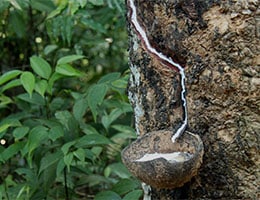 Latex is a term whose etymological root is found in the Latin language. This is the name given to the viscous liquid contained in the laticiferous vessels of various plants , with which numerous products can be made.
Latex is a term whose etymological root is found in the Latin language. This is the name given to the viscous liquid contained in the laticiferous vessels of various plants , with which numerous products can be made.
This substance, composed of resins , waxes , fats and other elements, circulates through these vessels of the plants. It is generally whitish, although yellowish, red and other shades of latex can be found.
The laticiferous cells are responsible for the production of latex. Typically, the latex used by humans on a commercial and industrial level comes from the Hevea brasiliensis species.
The plant structures that are responsible for secreting and containing latex under positive pressure are known as lacitiferous vessels, ducts or tubes . They are found in twenty plant families and can be linked to the phloem (a tissue that transports organic and inorganic nutrients) or found dispersed throughout the various tissues that make up the plant.
The lacitiferous cells are made up of several aligned lacitiferous cells, whose transverse walls are very thin and break when they mature, unlike what happens with the longitudinal ones, whose thickness is much greater.
When a lacitiferous cell reaches maturity, it may not have a nucleus and its number of cellular organelles may be very small. The lacitiferous can be classified into:
* non-articulated : they are also known as apocytic and are made up of a single elongated cell that goes from the root of the plant to its leaves without anastomosis occurring, that is, the union of the various elements of the structure;
* articulated : another name they receive is symplastic and their main feature is that they are formed by chains of laticiferous cells linked together by plasmodesmata or perforations in their common walls . In this case, anstomosis may or may not take place depending on whether or not the cells fuse, producing a network that runs through the entire plant.
It is important to mention that the latex of some plants has a high level of toxicity . There are aborigines who use this poisonous latex to make their arrows more deadly.
For the plant, latex can fulfill various functions. When it is toxic, it serves as a defense mechanism, for example. On the other hand, latex contributes to healing since, when it comes into contact with air, it coagulates and “closes” the opening from which it flowed.
 Latex is processed by man to produce multiple elements. In the field of medicine and nursing, latex is used to make gloves, masks, enemas and probes, to name a few possibilities.
Latex is processed by man to produce multiple elements. In the field of medicine and nursing, latex is used to make gloves, masks, enemas and probes, to name a few possibilities.
Latex is also used to produce shoe insoles, glue, balloons, pillows, mattresses, condoms, tires and tennis balls.
It should be noted that, according to the Royal Spanish Academy ( RAE ), rubber is a specific type of latex, generated by some intertropical plants. Nor should latex be confused with gum resin , another type of juice produced by certain vegetables.
There is a text composition system called LaTeX , which is aimed at the preparation of written documents that require very high typographic quality. Given its characteristics and the tools it offers to users, its application focuses especially on the production of books and articles of a scientific nature that include elements such as mathematical formulas.
Behind LaTeX we find a large number of macros of the typographic system called TeX , very popular in the fields of computing, physics and mathematics . Its author is Leslie Lamport , who in 1984 embarked on a mission to simplify the use of TeX. The typographic quality offered by LaTeX is considerable, and that is why it is so widely used by prestigious scientific publishers.
